 |

The
Brazilian map of orchids by state is the result of a nine-years research,
in the Brazilian and foreign literature and is available at the site
Brazilian Orchids (http://delfinadearaujo.com/estados/brasil.htm). The research wasn't limited to the occurrences in the states. The work in its complete version will be soon disposable under the form of a book or a CD and will include, besides the new species and occurrences, the nomenclatural changes (synonymies, transference or creation of genera and species) and justification of every information given with bibliographical citation even though it was adopted or not. The
southeast region, the most rich concerning the variety of species and
also in number of individuals, has always been the most privileged (and
still is) by the studies and researches, as a result, the survey is
the most complete. However, the Amazonian region has been surprising due
to the researches and the most recent journeys started in the 80th decades
(with Pedro Ivo Soares Braga, Francisco Miranda and Kleber Lacerda)
with a great push in the 90th and continued by João Batista Fernandes
da Silva's journeys and Manoela F. F. da Silva's researches (Goeldi
Museum - Pará). The Central Plateau has been also studied mainly
by Lou Menezes, João Aguiar Nogueira Batista, Luciano de B. Bianchetti.
Some researchers greatly contribute with the increasing of information
about occurrence, even though they don't work with a exclusive region,
such Vitorino Paiva Castro Neto, Marco Antonio Campacci, Fábio
de Barros. Finally, we realized that the number of species occurring in Brazil has raised, not only because of the new species but also due to new registers of occurrence in our territory. The diversification of the genera and species occurring in Brazil is really great (which is not definitively a news) and is due, mainly, to the diversity of the topographies and latitude, originating so different climatic conditions. Distribution of the species Basically, the species are distributed through two tropical forests and two well defined regions such as cerrado (savannah) and the "caatinga"(1): |
The
Amazon Forest, situated at the basin with the same name, covers, in
Brazil, the states of Amazonas, Pará, Amapá, Acre, part
of Rondônia, Roraima, Maranhão and Mato Grosso. Although
the temperature is quite high (38º) during the day, contrary to
our believes, the temperature drops, at night, down to 10ºC. The
mountainous regions most recently researched have been showing an high
number of species ( Roraima, Paracarima, Parima, Pico da Neblina). The
diversity of the existent habitats inside it makes appear genera and
species of unequal cultural needs regarding to the luminosity, environmental
humidity and temperature. |
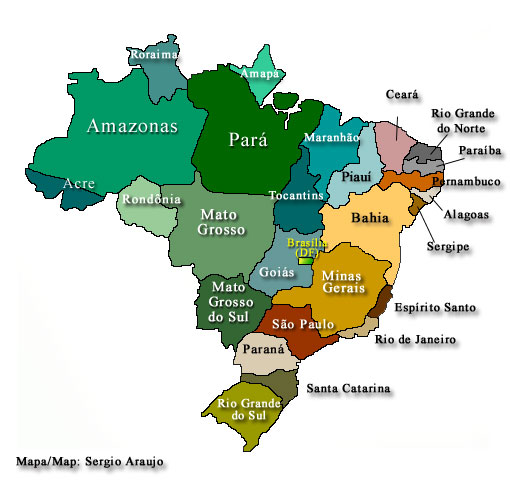 |
The
Atlantic Forest covers (or covered) the seaside strip along the states
of Rio Grande do Sul until Maranhão including the southeast of
Minas Gerais,
with their mountains with different altitudes and names depending on
the region. The most part of the species in our territory and the most
known genera and species occur inside there. In the mountainous regions,
the climate is more defined, the summer is warmer and rainy and the
winter is dry and cool or cold. It is called the first province of orchids
and shelters, more or less 60% of the genera ands species species existent
(Pabst, l975). The mist is frequently. At the lowlands, depending on the latitude, the summer is rainy but the winter is not so cool neither so dry. Going into the south, the summer is more pleasant and the winter is more cold. However, also there, the existence of different kinds of habitats (microclimates included) propitiating their richness. |
|
It is the second province of orchids characterized by a tropical warm
(even hot) climate, plentiful of atmospheric humidity and occupies a grande
part of the Brazilian territory (Pabst, 1975).
The vegetation of restinga is quite rich in Orchidaceae, specially if considered the rigorous climatic conditions (Francisco Miranda, l995), with the presence of Cyrtopodium, Epidendrum, Cattleya, Eltroplectris, Oncidium, Brassavola, Bletia, Encyclia, Vanilla, Catasetum, etc. The
region of cerrado (Savannah - Central Plateau) cover the areas of the
"chapadas" (plateaus) which reach 1.000m altitude, in the
states of Goiás, part of Maranhão, Piauí, west
of Minas Gerais, part of Mato Grosso and Bahia. In those areas, the
rains drop from October to April following by a strongly dry period
where the temperature really drops at night. Even during the summer,
the nights are fresh. The species of Cyrtopodium and Habenaria
are spread over that habitat. That is the third province situated in
the interior of the continent, in altitude from 600 to 1000m and the
"tables" (plateaus), a few mountains of mid high height, few
trees and palms (Pabst, l975). However, in some places, there is a long
period of drought such as in Chapada de Diamantina - Bahia, home the
Cattleya tenuis and elongata, where stayed, once, 7 years
without rains (Marcos Antonio Campacci). |
COMMENTS AND CURIOSITIES ABOUT THE GENERA AND SPECIES In this survey, some data have been confirmed: - The species in Brazil are distributed, mainly, through the southeast region (Atlantic Forest). - The states of Minas Gerais, Espírito Santo and Rio de Janeiro have at about 1/3 of the species occurring in Brazil. In the other hand, it clearly appears that the Amazonian region have much more species than we used to believe. One of the most curious registers is the occurrence of a rainy Amazonian area in the boundary of the states of Espírito Santo and Bahia called Hiléia Bahiana: "This is Rizzini's Tableland Forest, similar to the Amazonian Dryland forest differentiated for being located to the south of Bahia and at the northern extreme of Espírito Santo, where the pluvial indexes are high. This kind of forest contains many Amazonian species, some of them standing out for their large size, with a crown more than 40 meters high and with occurrence of orchids species sympathetic with those from Amazonas region such as Brassia, Cycnoches, Coryanthes, Maxillaria, Stellis, Chaubardia". (Augusto Ruschi, 1986). |
| Acacallis Lindl. | |
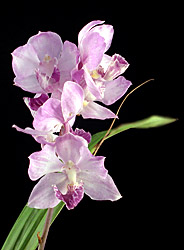 |
A
genus of great beauty with a color not too usual in Orchidaceae family,
it occurs in the Amazonian or at the boundaries regions (States of Acre,
Amazonas, Mato Grosso, Pará, Roraima and Rondônia). Acacallis
cyanea grows at the water level and very often the plants stay submerse
for several months (Francisco Miranda- l996). In journey, in l909-1910,
plants with 5m-stems have been found (Hoehne, 1930). |
| (AC, AM, MT, PA, RO, RR) (2) | |
| Aspasia Lindl. |
| Aspasia variegata Lindl. is the species with the greater dispersion mainly in the states of Amazonian region (States of AL, AM, AP, DF, ES, GO, MA, MT, PA, RJ, RO, RR, TO). |
Aspasia silvana F. Barros |
|
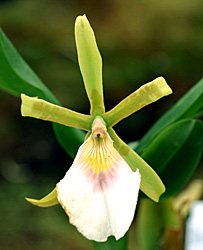 |
The
most recent species of the genus, described in l998. |
| (BA, ES, RJ) | |
| Batemania Rchb. f. |
| All species occur in the Amazonian region. |
| Beadlea Small | |
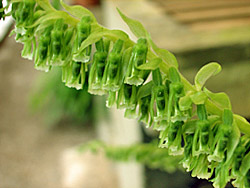 |
Terrestrial
genus with at about 20 species concentrated in the south and southeast
regions with shy incursions through Bahia and Pernambuco. |
| Bifrenaria Lindl. |
A genus with epiphyte and/or rupicolous species, almost of them concentrated in the south and southeast region, besides Bahia, except for Bifrenaria longicornis and Bifrenaria venezuelana in the Amazonian region. |
| Bifrenaria aureo-fulva(Hook) Lindl. | |
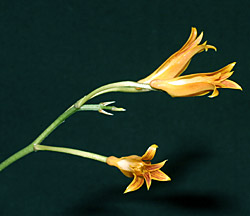
|
Found
in Atlantic Forest, plant epiphyte and, eventually, rupicolous (Coletânea
de Orquídeas Brasileiras 2, Bifrenaria, Editora Brasil Orquídeas). |
| (BA, ES, MG, PR, RJ, RS, SC, SP) | |
| Bletia Ruiz & Pavón |
Bletia catenulata Ruiz & Pavón has a distribution larger than was once believed and is dispersed into Goiás, Maranhão, Minas Gerais, Mato Grosso, Mato Grosso do Sul, Pará, Rio de Janeiro, São Paulo and Tocantins. It occurs in steeps banks associated to Phragmipedium vittatum in medium altitude and also occurs the sea level, in restinga (sandbank). |
| Catasetum
L.
C. Rich. ex. Kunth |
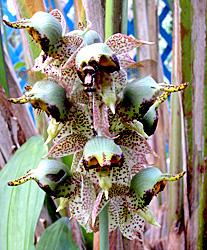 Ctsm sanguineum Lindl. & Paxton (MS) |
A
curious information is given by Francisco Miranda (Orchids from Brazilian
Amazon - l996): " ... Male and female flowers generally appear in separate inflorescences but in Catasetum it is relatively common for them to appear on the same inflorescence, and even together with hermaphrodite flowers. In such cases, the rule- which permits exceptions - is that the female flowers appear towards the bottom of the inflorescence, the hermaphrodite towards the center and the male flowers at the top." |
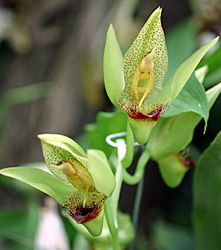 Ctsm schmidtianum Miranda & Lacerda (MT) |
| Cattleya Lindl. |
From
at about 50 (*) species vegetating from the Mexico until Argentina,
32 occurring in Brazil, without included the great number of varieties
inside the same species or hybrids between the species and another genera.
They appear since the extreme north (Pacaraima and Parima mountains,
in Roraima, in the boundary of Brazil and Venezuela and Guyana since
Rio Grande do Sul. The Atlantic Forest is the habitat which concentrates more species. The states of southeastern and Bahia (northeastern) is the most rich state with 14 species, followed by Espírito Santo with 13, Minas Gerais with 11, Rio de Janeiro with 10, São Paulo with 9. In the southeast region, they are concentrated in the east and move forward the west. |
| Cattleya acklandiae Lindl |
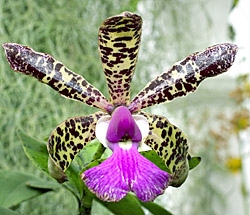 |
| (BA, ES) |
The Brazilian Amazonian region is the home of 7 species: Cattleya araguaiensis (**), eldorado, jenmanii, luteola, lawrenceana, mottae and violacea, besides 2 hybrids: C. x brymeriana (C. violacea x C. eldorado) and Brassocattleya x rubyi (Brassavola martiana x Cattleya eldorado, in the state of Amazonas). Perhaps another hybrid will be confirmed for the region, after finishing analyses based on DNA. |
| Cattleya luteola Lindl. | |
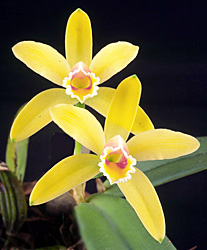 |
Dryland Forest of Amazon - dense rain forest. |
| (AC, AM, PA, RO) | |
| Cattleya violacea (H.B.K.) Rolfe | |
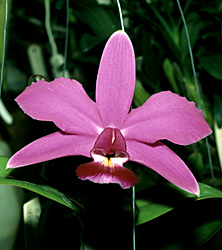 |
It grows in high humid environments and does not tolerate low temperatures (Kleber Lacerda, 1995).) |
| (AM, MS, MT, PA, RO, RR) | |
Due
to the capacity of hybridizing, only in the nature, the Cattleya
species are intercrossed for more than 38 times, and, with another genera,
31 times. It means, there is more natural hybrids than species. (*) Recently the species of Mexico and some from Central America have been transferred to the genus Guarianthe. (**) Recently transferred to the genus Cattleyella. |
![]()
| Caularthron
Raf.
A genus with 3 species with an exclusive distribution in the Amazonian region. |
| Caularthron bicornutum (Hook) Raf. | |
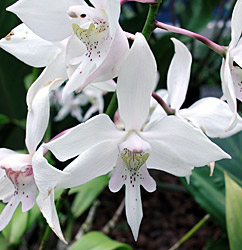 |
It
has a great area de dispersion in the Amazon region, occurring in the
Central Amazon Campinas (Woodland) and igapós (Flood forests)
in open and enlightened places until Venezuela (Francisco Miranda, l996)
|
| (AM, PA, RO, RR) | |
![]()
| Cirrhaea Lindl. |
| A genus of a few species occurring in the south and southeastern with an only exception to the state of Bahia (Cirrhaea silvana) |
| Cirrhaea saccata Lindl. |
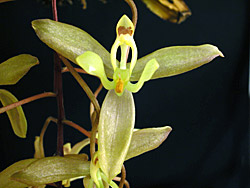 |
| (PR, RS, RJ, SC, SP) |
![]()
| Coryanthes Hook. |
This
genus is concentrated in the Amazonian region but it also appears in the
region called "Hiléia bahiana" (Bahia and Espírito
Santo- Coryanthes speciosa). |
![]()
| Cyrtopodium Robert Brown |
The
Central Plateau is the geographical center of distribution of the genus
and Brazil is the most rich country with almost 35 species, some of
them, recently described. Cyrtopodium cristatum Lindl is the
species most spread considering the number of states it is distributed
(it grows in, at least, 14 states) followed by Cyrtopodium eugenii
Rchb. f e Cyrtopodium polyphyllum (Vell.) Pabst ex F. Barros
(most known as Cyrtopodium paranaense) in 13 states. |
Until
today, the occurrence of the species former locally known as Cyrtopodium
andersonii is not clarified as well as if Cyrtopodium
glutiniferum Raddi and Cyrtopodium cardiochilum
Lindl. are synonyms or two valid species. |
| Cyrtopodium intermedium Brade | |
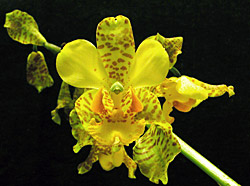 |
Rare plant, considered as an hybrid of Cyrtopodium gigas (Vell.) Hoehne and Cyrtopodium palmifrons Rchb. f. occurring in a small region of the state of Minas Gerais. |
| Dimerandra Schltr. |
| Dimerandra emarginata (Meyer) Hoehne | |
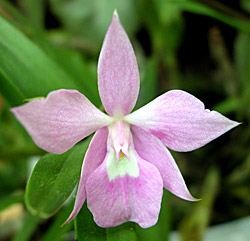
|
Dimerandra
emarginata has a curious occurrence, it is present in the north,
northeast region and in "Hiléia Bahiana"
(south of Bahia and north of Espírito Santo). |
| (AL, AP, AM, BA, CE, ES, MA, PA, PE, SE) | |
| Eltroplectris Rafinesque |
| Terrestrial genera with 11 species. |
| Eltroplectris triloba (Lindl) Pabst | |
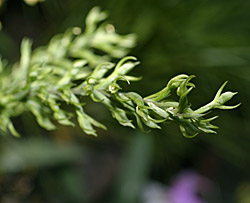 |
It occurs in sandbanks areas (restinga.) |
| (ES, RJ, RS, SP). | |
| Encyclia Hook. |
| It has almost 50 species and/or natural hybrids. |
| Encyclia oncidioides |
| There is register of occurrence in every state, from the north to the south, from east to west (Mato Grosso), in tropical humid forest and also in Atlantic Forest (Coletânea de Orquídeas Brasileiras 1, Encyclia, CAOB) |
| (AL, AM, BA, AP, CE, DF, ES, MG, MT, PB, PA, PE, PR, RJ, RN, RS, SC, SP, SE) |
![]()
| Epidendrum L. |
At
about 40 species grow in Brazil, as epiphyte, rupicolous or terrestrial,
occurring in every region of the country. |
| Epidendrum anceps Jacq., Epidendrum rigidum Jacq. and Epidendrum difforme Jacq. |
| appear in 17 states in different regions. |
| Epidendrum densiflorum Hook. | |
It
grows in, at least, 15 states from the Amazonas until Rio Grande do Sul. |
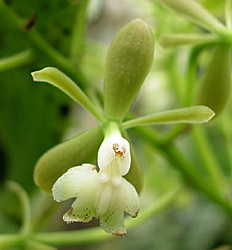 |
| (AL, AM, BA, DF, ES, GO, MG, MT, PE, PA, PR, RJ, RS, SC, SP) | |
| Epidendrum nocturnum Jacq. |
is
present in 19 states, since the extreme north until Rio Grande do Sul.
|
| (1) Caatinga: stunted rather sparse forest that is leafless in the dry season and is widespread in areas of small rainfall in northeastern of Brazil (Webster's Third New International Dictionary) |
| (2) See the legends in part II. |
| Photos: Sergio Araujo - ©Sergio Araujo-2005 |
|
Any
kind of reproduction of any type of material of this site - texts,
lay-out, photos, images and others - is strictly forbidden without
the previous written permission of the authors. Any solicitation or information should be done by the e-mail bo@sergioaraujo.com |